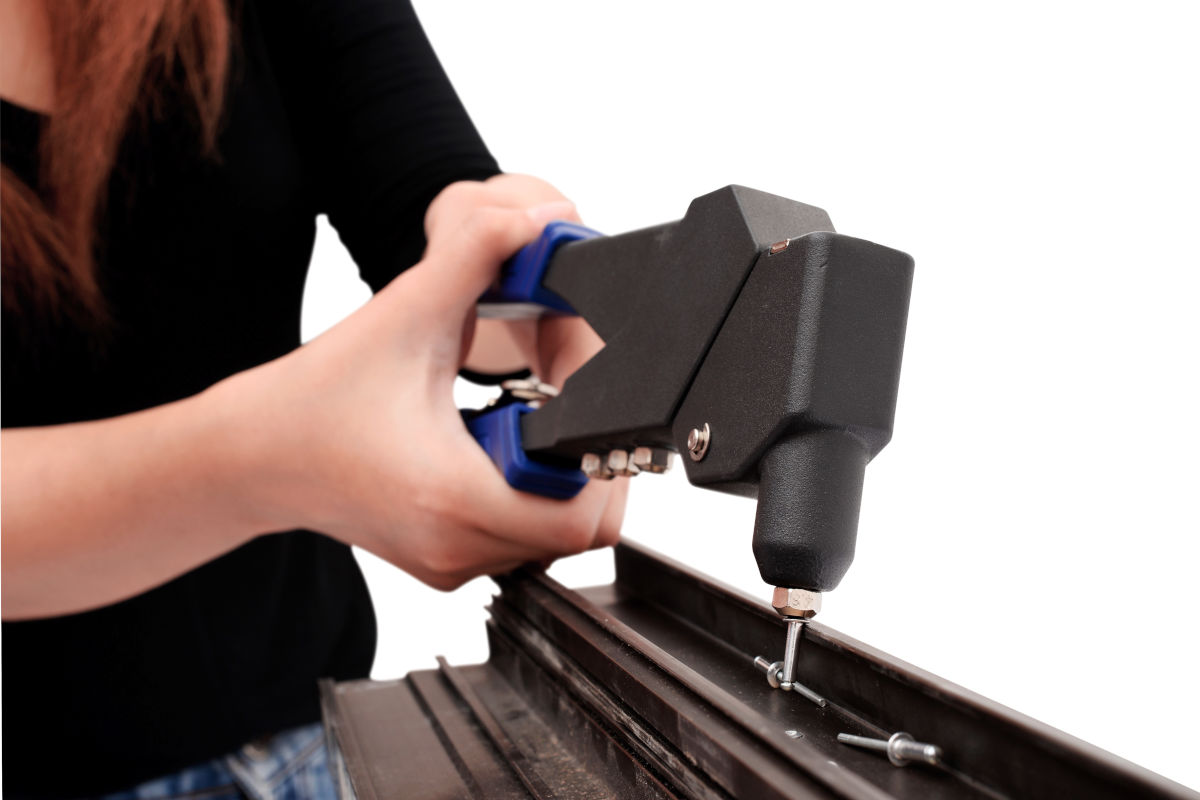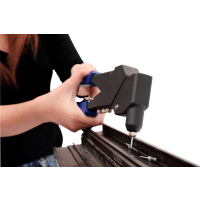- Home
- Blog
- Screws & Fixings
- How To Use A Rivet Gun
How To Use A Rivet Gun

Screws and bolts make an excellent solution for fastening materials but can loosen over time, especially when the structure is exposed to frequent vibrations. However, rivets offer an excellent alternative to screws and bolts and won't loosen over time.
Although riveting is complex, rivet guns are pretty straightforward tools that are easy to use. If you're looking for a way to fasten joints that will withstand the tests of time, this article will provide you with everything you need to know.
What Is A Rivet Gun?
Pop rivet has become a commonly used term to describe any blind rivet with a shank and mandrel head, and pop rivets are often used instead of nails, bolts, and screws when joining two materials together. The pop rivet gun is the tool used to apply pop rivets.
The rivet gun is simply a pair of handles connected to a set of ratchets or wheels. The ratchets crank to pull the rivet pin into the rivet gun by squeezing these ratchets together. A rivet is a long pin that resembles a nail with a thick head made of aluminum or another pliable material.
When you pull the handles of the rivet gun together, this creates a torque that pulls the pin into the gun. The head of the rivet then presses against the gun, flattening it. The rivet pin will then break at an intentional weak spot, leaving only the flattened head behind. The flattened head holds the newly-riveted materials together.
How Do You Use A Rivet Gun?
To use a rivet gun, you must first create pre-drilled holes in the materials you wish to join together. Insert your rivet into the pre-drilled holes. Then, insert the rivet pin into your gun. Ensure that the rivet head presses against the body of the gun.
Pull the levers together. If the pin doesn't snap, you should release the levers and pull them again. By doing this, you should ensure you finish placing your rivet.
What Is A Rivet Gun Used For?
There are several uses for a rivet gun, depending on whether the rivets are heavy-duty or more lightweight.
Lightweight pop rivet tools prove useful for merging thin metals and other thin materials in simple projects. You can use them for repairing panels or connecting two pieces of acrylic.
You can use a rivet tool for more heavy-duty tasks, like in a construction environment, where you may need to apply many rivets in succession. For this, it's best to use power rivet tools instead of manual tools.
Type Of Rivet Gun
Choosing the right tool for the job is essential. When it comes to selecting which pop rivet tool is right for you, there are three main categories to evaluate:
Manual Tools
Manual tools are most aptly suited for repair tasks and simple projects. Manual tools aren't recommended for projects where you will need to fix many rivets in succession, as squeezing the handles of a manual rivet gun together requires strength, and your arms could become fatigued if working with this tool for too long. So, be sure to select manual tools for placing a small number of rivets. Hand rivet tools are the most cost-effective option, with most manual rivet guns being available for under $50.
Cordless Tools
The lithium-ion battery has enabled handheld tools to achieve the same power as standard tools. Battery-operated and cordless pop rivet tools are an ideal solution for situations where you need a power rivet gun but don't have access to a power source close by.
Pneumatic Tools
Big jobs with repetitive rivet placing are impossible to perform with a manual rivet tool. This is where pneumatic rivet-placing tools come in handy. Pneumatic tools allow the fast and consistent placing of many rivets in succession. However, they require a power source which makes them less ideal for use on job sites and remote locations.
Installing Rivets Without A Rivet Gun
You can install a rivet without using a rivet gun, though you will need some other supplies to perform this task. Please note that stainless steel rivets are virtually impossible to fasten without using a tool. Firstly, you will need a bolt with its own nut to fit into the rivet nut. You will also need a washer compatible with your bolt and two open-end wrenches.
To install your rivet without using a gun, place the rivet into the hole. Then, thread on the loose nut and put the bolt through your washer. Then, insert the bolt into the rivet nut as far as possible and manually screw it in as far as the washer will let you. Loosen the nut and unscrew the bolt, and you should fasten your rivet.
Summary
A rivet gun provides an excellent alternative to regular nuts and bolts and reduces the risk of loosening due to vibrations. You can use rivets for larger industrial projects and smaller automotive, repair, or DIY projects.
It is vital to know which kind of rivet gun will be best suited for your project, which involves analyzing how many rivets you need to place and whether you will need to place rivets in a remote location.
Now you have all the information you need on rivets, their uses, and how to place them, you can start using this new method in your projects to create solid and sustainable joints.
FAQs
How much does a rivet gun cost?
A hand rivet gun can cost between $20 and $100. More high-spec and professional hand rivet guns will be on the upside of $60. Generally, a standard-quality pop rivet gun will cost $20 and $40.
If you're looking to complete a larger project involving placing a high number of rivets, you will need a pneumatic gun. For a high-quality pneumatic rivet gun, you should generally expect to pay upwards of $150.
Cordless rivet guns tend to be vastly more expensive, exceeding $800. It is advisable to evaluate whether a cordless rivet gun is necessary for your project or whether a pneumatic gun will suffice.
What are the uses of rivets?
Steel rivets are commonly used to join static structures such as bridges, building frames, and cranes. Rivets work in lieu of bolts and screws due to their ability to withstand vibrations and provide long-lasting joints that don't weaken over time.
You can also use rivets for smaller projects, such as connecting leather and wood, fixing metals, and adding decorative accents to DIY projects.
How do you use a rivet gun on wood?
This method of riveting works for both wood and leather. You should begin by drilling a hole into the wood that is the same size as your rivet. Then, line up your second piece of wood to drill your hole through.
When loading your rivet gun to apply rivets to wood, you must also place a washer around your rivet. The washer will stop your rivet from pushing through the material, as wood is significantly more delicate than metal, which rivets are traditionally applied to. Once you have placed your washers, you can compress the rivet without damaging the material.


